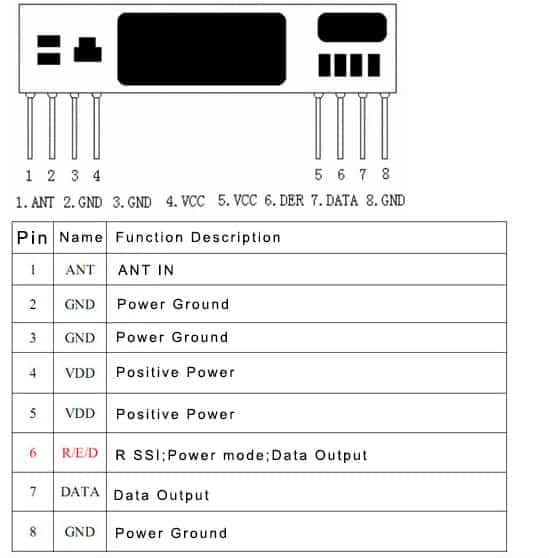RXB6 433 MHz Superheterodyne Wireless Receiver Module – Support Documentation
Overview
The RXB6 is a high-sensitivity 433.92 MHz ASK/OOK wireless receiver, ideal for remote control systems, sensor networks, and simple wireless data links. Its superheterodyne design offers excellent selectivity, stability, and low power consumption. It is commonly used in garage door remotes, weather stations, alarm systems, and Arduino-based IoT projects.

Features
- 433.92 MHz frequency
- Superheterodyne with PLL and AGC
- Wide voltage range: 3.0 V to 5.5 V
- Low power operation: ~6 mA
- High sensitivity: up to –116 dBm
- RSSI output (on some versions)
- Compact 8-pin package
Specifications
| Parameter | Value |
|---|---|
| Operating Frequency | 433.92 MHz |
| Modulation | ASK / OOK |
| Voltage Supply | 3.0 V – 5.5 V DC |
| Current Consumption | ~6 mA at 3.3 V |
| Sensitivity | –110 dBm to –116 dBm typical |
| Data Rate | Up to 5 kbps (typical) |
| Output | TTL-level DATA |
| Operating Temp. | –40 °C to +85 °C |
Pin-Out Table
| Pin # | Label | Function |
|---|---|---|
| 1 | ANT | Antenna input – connect a 17.3 cm wire (1/4 wave) |
| 2 | GND | Antenna ground – connect to ground plane or GND rail |
| 3 | GND | Power ground |
| 4 | VCC | Power input (3.0 V to 5.5 V) |
| 5 | VCC | Secondary VCC (internally connected) |
| 6 | DER / R-EN / RSSI | Receive Enable (pull high or leave floating), or RSSI output (on some models) |
| 7 | DATA | Digital data output (TTL) |
| 8 | GND | Power ground |
Wiring Example (Arduino)
// Simple RXB6 receiver sketch
#define rxPin 2
void setup() {
pinMode(rxPin, INPUT);
Serial.begin(9600);
}
void loop() {
int value = digitalRead(rxPin);
Serial.println(value);
delay(10);
}
Recommended Antenna Design
For best reception, use a 1/4 wave straight wire antenna:
- Length: ~17.3 cm for 433.92 MHz
- Material: Solid copper or tinned wire
- Orientation: Vertical, away from metal objects
- Enhancement: Add a ground plane or mount on a PCB with a defined GND pour
Installation Notes
- Use a decoupling capacitor (10 µF and 0.1 µF) across VCC and GND near the module
- Mount the module away from sources of electrical noise
- Use a pull-down resistor on the DATA line if needed to stabilise output
- Ensure transmitter is ASK/OOK, not FSK or LoRa
Module Variants
The RXB6 module may have slight layout or pin function differences depending on the manufacturer:
- Some versions expose an RSSI output on pin 6
- Others have pin 6 as an enable pin—tie to VCC if unused
- Always verify with your unit’s silkscreen or check continuity with a multimeter
Troubleshooting Guide
| Issue | Cause | Solution |
|---|---|---|
| No data on output | Incorrect pin wiring or no transmission | Double-check connections; ensure TX is working and antenna is present |
| Unstable data | Power noise or weak signal | Add decoupling caps, check antenna and distance |
| Short range | Poor antenna or interference | Use proper wire length, relocate module away from metal/EMI |
| Module gets hot | Over-voltage or short circuit | Check supply voltage; ensure pins aren’t shorted |
Frequently Asked Questions (FAQs)
- Can I use this module to receive sensor data?
Yes, if the sensor’s transmitter uses ASK or OOK at 433 MHz. - Can I connect the DATA pin to a 3.3 V microcontroller?
Yes, DATA is typically under 3.3 V logic compatible. - Does it support bidirectional communication?
No, RXB6 is receive-only; pair it with a 433 MHz ASK transmitter for two-way systems. - How can I extend range?
Use a tuned antenna, reduce interference, and use clear line of sight.
Safety Considerations
- Do not exceed 5.5 V on VCC
- Avoid direct short between pins
- Use a proper regulated power supply
- Follow local regulations for 433 MHz device use
